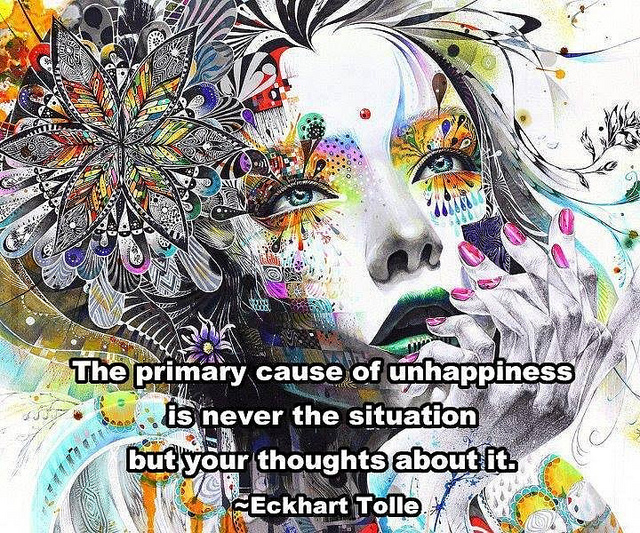When I was much younger, I remember being mesmerised by adult interactions.
Not for the content, what interested me more was the emotional responses. I couldn’t understand why certain ideas would create vehement emotions, often with seemingly instantaneous and irrational exuberance.
It made no sense to me why adults took themselves so seriously, and stuck to emotional and thought-patterns that seemed intractable. The patterns seemed more dangerous than the thoughts themselves. Even the most unfeigned emotions gathered pace and, at times, the result was anarchy.
As I developed, I notice it wasn’t just emotions that were unstable, sometimes mercurial, and often irrational. I started to understand and experience the range of thought-systems around me, and the amazing certainty adults had about particular ideas.
Why do people believe their thoughts or feelings?
Or perhaps a better question: Why do they take their thoughts or feelings so seriously?
When we are believing thoughts or strung out by feelings, we are not experiencing life as it is—endless openness. We fall into grace when we let go of the pull of the mind and become what the author Adyashanti calls “emptiness dancing.”
It is not that thoughts or feelings are not valid—they are always valid. Yet when we take them as reality, that is when we suffer. This preoccupation has the potential to spiral into an abyss of our own creation.
The moment a thought comes into our mind, it limits our experience and takes us out of the opportunity of being in the present moment, true reality.
We tend to see our patterns as stuck in concrete, unchangeable realities, when in fact any pattern can be changed or at least, adjusted. The personality is not set in stone.
What is it to be endless openness, free of personality and closed concepts of the self? It is to move within life from a space that is full of love.
Adyashanti points out that, “When we believe what we think, when we take our thinking to be reality, we will suffer.”
According to this concept, we are suffering simply by believing our thoughts to be real. I would qualify that with it depends on the quality of our thoughts and whether it is appropriate to keep repeating the same ones. Some thoughts can actually create peace.
The core takeaway idea is that thoughts are not real. Thoughts are not unchangeable. Thoughts are only signposts to show us patterns in our personality and non-acceptance of past experiences. A similar argument can be made and understanding reached about our feelings, because thoughts and feelings are intertwined.
What about the quality of our thoughts?
Underlying our unwholesome thoughts is the feeling of not being whole—not being part of the whole creation. Deep within the recesses of our subconsciousness, the seed of unworthiness has been planted by traditional religions.
Much angst is caused by disconnection—disconnection to others, disconnection to ourselves and our intrinsic nature, and linked to all of these is disconnection to life itself, or god consciousness. It is we who have created a primitive version of god consciousness that is dark, jealous, and vengeful.
God is not dark—it is we who have judged ourselves. It is we who have collected shame and guilt through judging our nature and our behaviour as unworthy or unforgivable. Poet Rainer Maria Rilke famously wrote:
“Perhaps all the dragons in our lives are princesses who are only waiting to see us act, just once, with beauty and courage. Perhaps everything that frightens us is, in its deepest essence, something helpless that wants our love.”
We are here to be, not to do—we are here in love.
Because our social conditioning has brainwashed us into believing that “doing” is more important than “being” and more than that, that “being” is a character flaw, we are struggling with the pressure to “do” more.
The basic void is in our self-identity as not being good, not being worthy enough. We start from this feeling of lack, a deficit in perception. We are feeling we are not and have not achieved enough. The source of these trends comes from the over-dominance of the left-hemisphere of our brain versus the right. A left-brain functioning society views feeling and being in our bodies as “lesser” than manifesting or achieving some goal.
By such thinking, the perfection of imperfection and the wholeness of being alive is diminished.
Would a loving God frown on us for being less than who we are for not having achieved some social status or monetary goal?
It is how we are perceiving ourselves that is at fault—and the whole capitalist marketing system that is based on creating demand. It is a simple strategy to send the message: “You are not enough”—and hence need a branded product to feel okay.
Outside of consumerism, where would we be as a society?
If we refine our idea of joy and fulfillment, it leads us down the path of consuming less and residing in more spaciousness, increasing the room we allow for silence. If achievement defines our self-identity and meaning defines our goals, through a spiritual sadhana practice, we can shift our identity into something more pure, refined, and long-lasting.
Then we can move within life with the wisdom of humility and the courage of love, from a space that is full of love. It is the empty space that is abandoned that feeds unhealthy behaviours. The cultivation of one’s internal space is much like a garden. It can be cared for and developed and made into something beautiful, or neglected allowing the weeds to take over.
It takes mental agility to reframe our self-view and a willingness to morph our view that the personality is unadaptable. It takes a new way of seeing things to remove the barriers and step forward into a new sense of self.
Nisargadatta Maharaj offers a spiritual guideline of what life may look like on the other side of ego:
“Wisdom is knowing I am nothing,
Love is knowing I am everything,
and between the two my life moves.”
The key guideline is to simplify one’s sense of self, be open to change the understanding of what we considered our intractable “personality,” and not take too seriously any particular thought or feeling. Instead we can welcome in the fresh pastures of love for ourselves and compassion for others.
As one invites in new possibility and the potential for changing personality traits and habits, one enters the field of endless openness.
~
~
~
Author: David Zenon Starlyte
Image: Flickr/Susan Ackeridge
Editor: Travis May












Read 0 comments and reply